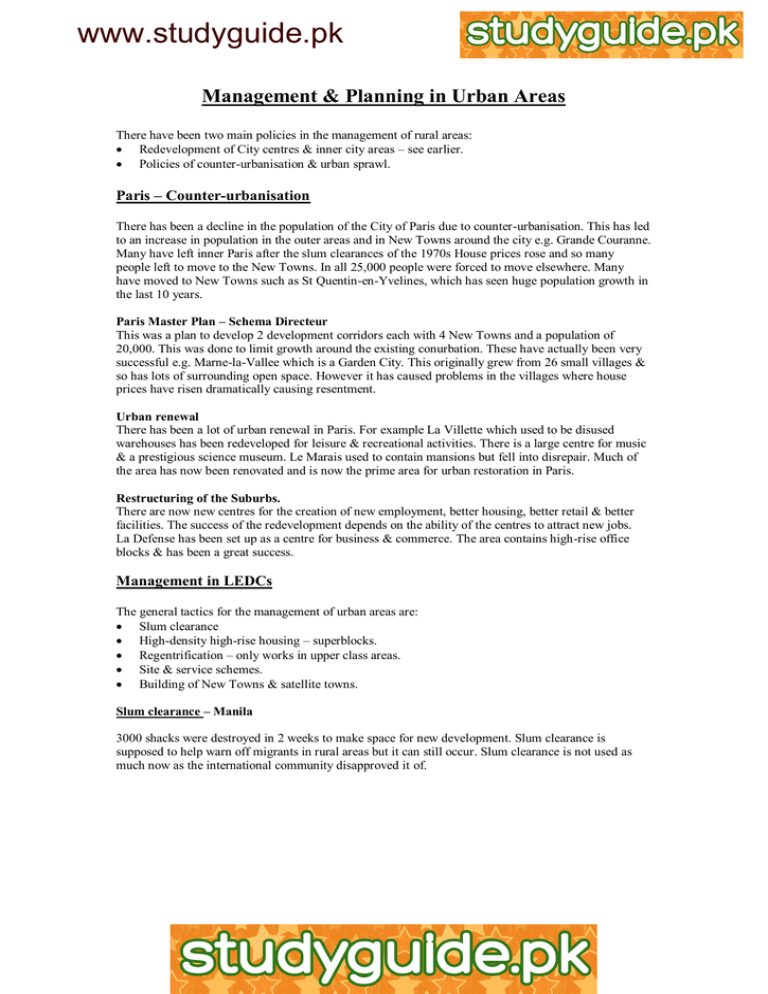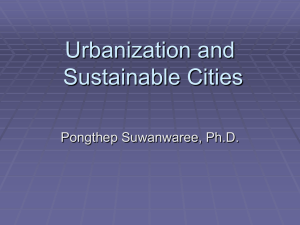www.studyguide.pk Management & Planning in Urban Areas
advertisement

www.studyguide.pk Management & Planning in Urban Areas There have been two main policies in the management of rural areas: Redevelopment of City centres & inner city areas – see earlier. Policies of counter-urbanisation & urban sprawl. Paris – Counter-urbanisation There has been a decline in the population of the City of Paris due to counter-urbanisation. This has led to an increase in population in the outer areas and in New Towns around the city e.g. Grande Couranne. Many have left inner Paris after the slum clearances of the 1970s House prices rose and so many people left to move to the New Towns. In all 25,000 people were forced to move elsewhere. Many have moved to New Towns such as St Quentin-en-Yvelines, which has seen huge population growth in the last 10 years. Paris Master Plan – Schema Directeur This was a plan to develop 2 development corridors each with 4 New Towns and a population of 20,000. This was done to limit growth around the existing conurbation. These have actually been very successful e.g. Marne-la-Vallee which is a Garden City. This originally grew from 26 small villages & so has lots of surrounding open space. However it has caused problems in the villages where house prices have risen dramatically causing resentment. Urban renewal There has been a lot of urban renewal in Paris. For example La Villette which used to be disused warehouses has been redeveloped for leisure & recreational activities. There is a large centre for music & a prestigious science museum. Le Marais used to contain mansions but fell into disrepair. Much of the area has now been renovated and is now the prime area for urban restoration in Paris. Restructuring of the Suburbs. There are now new centres for the creation of new employment, better housing, better retail & better facilities. The success of the redevelopment depends on the ability of the centres to attract new jobs. La Defense has been set up as a centre for business & commerce. The area contains high-rise office blocks & has been a great success. Management in LEDCs The general tactics for the management of urban areas are: Slum clearance High-density high-rise housing – superblocks. Regentrification – only works in upper class areas. Site & service schemes. Building of New Towns & satellite towns. Slum clearance – Manila 3000 shacks were destroyed in 2 weeks to make space for new development. Slum clearance is supposed to help warn off migrants in rural areas but it can still occur. Slum clearance is not used as much now as the international community disapproved it of. www.studyguide.pk New Town – Brasilia Brasilia was built to remove pressure from the triangle around Sao Paulo, Belo-Horizonte & Rio and to open up inland areas. It has a population of 1.7 million. The town has been built in the shape of an aeroplane. Fuselage – Government buildings, commerce, culture etc. Wings – Housing. The town was built with a good environment. There is lots of open space and an artificial lake formed from dammed rivers. However, the town was built especially for motorists so they could get to work without traffic lights. This is dangerous for those who want to walk, as they have to cross 3 lane expressways. Housing – Superblocks/superquadras Complete self-contained units. 9-11 apartment blocks housing 2500 each. Apartments are luxurious & expensive. Contains all the services needed. However, there have been some problems. Brasilia is a bureaucratic city & so there is very little industry. Also there is little or no housing for the poor although there are already squatter settlements forming. Site & Service Schemes Improvement will be a lot faster with help such as aided self-help (ASH). The land should be legalised to allow people to make their own improvements to property. It would also help to bring in technical help from other countries. Calcutta Co-operatives have been formed to help improve the area. This means they borrow money from people they trust to improve quality of life & invest in the local area. 3 Areas: 1. Upgrade housing 2. Site & Service Scheme – common on the peripheries. In some areas it is unsuccessful, as there are less job opportunities & a poorer transport system on the outskirts. 3. Core housing scheme – A step up from self-help. May include bathrooms & sanitation with a variety of different house types. Rocinha, Rio Self-help schemes have transformed the favela into a small city with brick housing. The local authorities have also added pavements, street lighting, electricity, water pipes etc. Shops & industry has also been set-up to create jobs, although mainly in the informal sector. Similarly a project called favela Bairro £200 million has been set aside for improvements, Buildings have been replaced, streets made wider, pavements, and electricity etc. has been laid. Also labour has been used in the favela to develop new skills.





